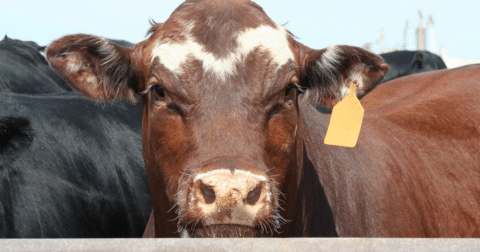News
Meat Consumption Grows in US and Asia, While Europe is on the Decline
Climate•3 min read
Reported
Cattle ranching contributes to the dangerous conditions making wildfires like Smokehouse Creek far more likely.


Words by Grace Hussain
For the past week, Texas has been engulfed with what has grown to become the largest wildfire in the state’s history. Dubbed the Smokehouse Creek Fire, it has already burned more than a million acres of land and claimed at least two human lives and thousands of animals, both domestic and wild. The flames have primarily impacted Texas’ panhandle region, an area home to the majority of the state’s cattle.
The cattle inhabiting the region are not only victims to the flames but their presence — on the state’s 250,000 farms — are also contributing to the problem of increasingly common and severe wildfires, argue some scientists. “Not only has cattle ranching probably made the area more prone to fire from an ecological perspective,” Jennifer Molidor — an environmental researcher with the Center for Biological Diversity — told Sentient in an email, “but it’s also driving climate change which is causing more fire and longer fire seasons.”
Cattle ranching is a major driver of food-related greenhouse gas emissions. And annually, cattle are responsible for a whopping 231 billion tons of methane emissions.
However, not everyone is on the same page when it comes to the impacts of cattle grazing on the land. Many within the cattle industry argue that ranching can actually stop the spread of fires, a claim of which Molidor is skeptical.
Videos of cattle running from the fires surfaced on Wednesday of last week drawing the attention of people around the country. Some ranchers are cutting fences and moving herds to areas with less risk or throwing open gates. In most cases, however, when farmers evacuate, the animals are left behind. Early estimates suggest that the livestock death toll reaches into the tens of thousands.
One of the Texas panhandle’s representatives in Congress, Ronny Jackson, had the opportunity to fly over the damaged area in a helicopter. In a video posted to X (formerly Twitter) he recounted seeing “dead animals everywhere,” as well as numerous animals who will “need to be put down” due to serious burns.
Yet the presence of so many cattle may also be a reason why the fires are able to spread so easily. Cattle grazing has been linked to an increase of invasive grasses, points out Molidor, which “does not benefit fire management.” Invasive species of grass tend to burn more readily than native species. One type of grass raising particular concern is cheatgrass, which grows quickly where cattle graze, replacing the more flame resistant indigenous vegetation.
“This is not where or how cows evolved to graze, and it’s not good for the cows or the land,” says Molidor. Cattle continue to graze millions of acres of land across the western United States, largely because the Bureau of Land Management — the entity responsible for managing federal lands — has deferred to industry interests at the expense of environmental protection, some environmental groups argue.
Unsurprisingly, some cattle ranching groups disagree with this assessment, and point to research demonstrating that cattle grazing can stop the spread of fires by creating fuel breaks — cleared areas of brush where fires lack fuel. However, as environmentalists point out, fuel breaks often fail in extreme conditions like those in Texas. Days before the fires sparked, meteorologists cautioned that the unseasonably hot, dry weather could lead to disaster. To make matters worse, as global temperatures rise in coming years thanks to climate change, conditions conducive to extreme fires across the country are slated to worsen.
While fire can play a pivotal role in the health of some ecosystems, the proliferation of non-native plants and climate change are making fires more common and severe, impacting more than just cattle. Over the last 40 years the incidence of megafires has jumped by 1,000 percent, with an increasing impact on a wide variety of wildlife.
Wildlife, who are often already struggling due to the destruction of their ecosystems by grazing and trampling by cattle, are severely also affected by fires. One culprit is the fencing constructed by ranchers to contain cattle, according to Molidor, which can make escape difficult and add to the lasting ecological effects of the fires. “Severe fires can mean disconnection of wildlife corridors…” she said in an email to Sentient. “It can also mean runoff of ash and debris into lakes and streams, disrupting aquatic species and all who rely on the water resources for sustenance.”
Not everyone agrees with Molidor’s assessment. “Wildlife is equipped by nature to take care of themselves in most situations,” Lerrin Johnson with the Texas Parks and Wildlife Department told Sentient via email. “Big game animals such as white-tailed deer and pronghorn antelope can evade fire, burrowing animals seek refuge underground and birds fly out of harm’s way.”
Yet for Molidor, the fires are a clear example of why “we need less cows.” From her perspective, “long term, sensible and just agriculture is going to have to be sustainable, and this is not it. We cannot continue to cattle ranch ourselves and the planet we share into oblivion.”